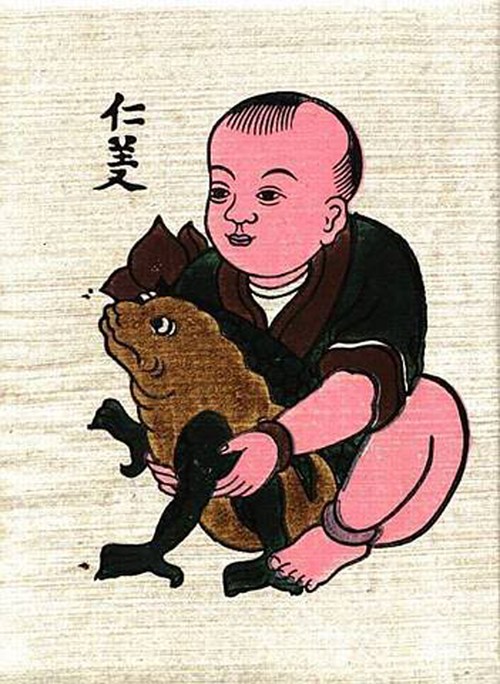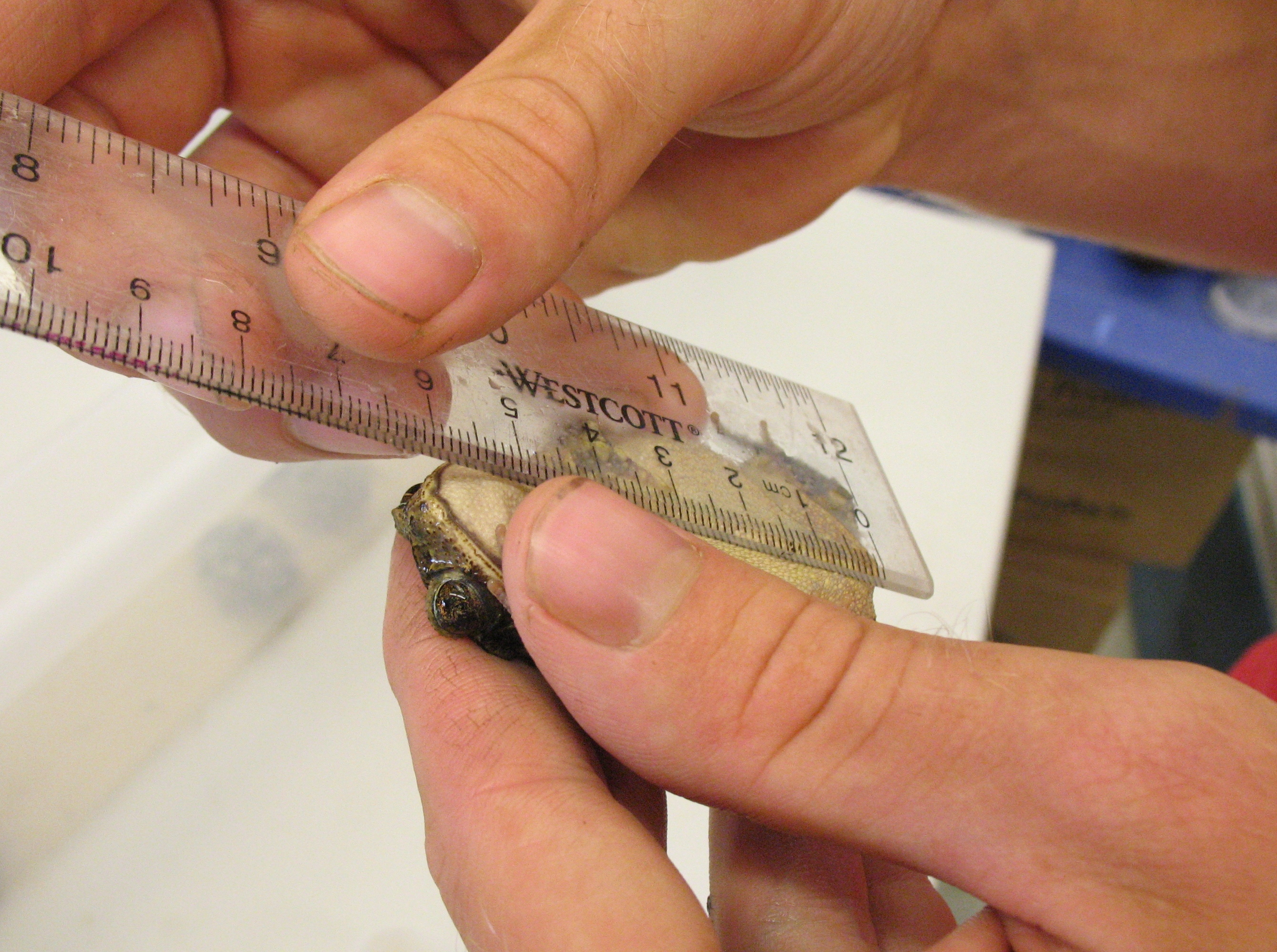|
Bufo Exiguus
''Bufo exiguus'', the Guangdong stream toad, is a species of toad in the family Bufonidae. It was first described in 2023 within Mt. Nankun, of the Guangdong Providence of China China, officially the People's Republic of China (PRC), is a country in East Asia. With population of China, a population exceeding 1.4 billion, it is the list of countries by population (United Nations), second-most populous country after .... They are a stream-dwelling toad that inhabits primarily slow moving mountainous streams. Description These toads are a faded greyish-brown in color.Adult males of B. Exiguus measure about 43.2–43.3 mm (1.7 in) while adult females measure to about 48.5–52.4 mm (1.9–2.1 in) in snout-to-vent length. Both the tympanum and tarsal fold are notably absent. The paratoid glands are reduced and oblong in shape. Males possess several white granular nuptial spinules on the inner surfaces of their fingers. References Amphibians described in 2023 ex ... [...More Info...] [...Related Items...] OR: [Wikipedia] [Google] [Baidu] |
Toad
Toad (also known as a hoptoad) is a common name for certain frogs, especially of the family Bufonidae, that are characterized by dry, leathery skin, short legs, and large bumps covering the parotoid glands. In popular culture (folk taxonomy), toads are distinguished from frogs by their drier, rougher skin and association with more terrestrial habitats. However, this distinction does not align precisely with scientific taxonomy. List of toad families In scientific taxonomy, toads include the true toads (Bufonidae) and various other terrestrial or warty-skinned frogs. Non-bufonid "toads" can be found in the families: * Bombinatoridae ( fire-bellied toads and jungle toads) * Calyptocephalellidae ( helmeted water toad and false toads) * Discoglossidae ( midwife toads) * Myobatrachidae (Australian toadlets) * Pelobatidae ( European spadefoot toad) * Rhinophrynidae ( burrowing toads) * Scaphiopodidae ( American spadefoot toads) * Microhylidae ( narrowmouth toads) ... [...More Info...] [...Related Items...] OR: [Wikipedia] [Google] [Baidu] |
True Toad
A true toad is any member of the family Bufonidae, in the order Anura (frogs and toads). This is the only family of anurans in which all members are known as toads, although some may be called frogs (such as harlequin frogs). The bufonids now comprise more than 35 genera, '' Bufo'' being the best known. History Bufonidae is thought to have originated in South America. Some studies date the origin of the group to after the breakup of Gondwana, about 78–99 million years ago in the Late Cretaceous. In contrast, other studies have dated the origin of the group to the early Paleocene. The bufonids likely radiated out of South America during the Eocene, with the entire radiation occurring during the Eocene to Oligocene, marking an extremely rapid divergence likely facilitated by the Paleogene's changing climatic conditions. Taxonomy The following phylogeny of most genera in the family is based on Portik and Papenfuss, 2015:, Chan ''et al.'', 2016, Chandramouli ''et al.'', 201 ... [...More Info...] [...Related Items...] OR: [Wikipedia] [Google] [Baidu] |
Guangdong
) means "wide" or "vast", and has been associated with the region since the creation of Guang Prefecture in AD 226. The name "''Guang''" ultimately came from Guangxin ( zh, labels=no, first=t, t= , s=广信), an outpost established in Han dynasty near modern Wuzhou, whose name is a reference to an order by Emperor Wu of Han to "widely bestow favors and sow trust". Together, Guangdong and Guangxi are called ''Liangguang, Loeng gwong'' ( zh, labels=no, first=t, t=兩廣, s=两广 , p=liǎng guǎng) During the Song dynasty, the Two Guangs were formally separated as ''Guǎngnán Dōnglù'' ( zh, first=t, t=廣南東路, s=广南东路, l=East Circuit (administrative division), Circuit in Southern Guang , labels=no) and ''Guǎngnán Xīlù'' ( zh, first=t, t=廣南西路, s=广南西路, l=West Circuit (administrative division), Circuit in Southern Guang , labels=no), which became abbreviated as ''Guǎngdōng Lù'' ( zh, first=t, t=廣東路, s=广东路 , labels=no) and ''Guǎngxī Lù ... [...More Info...] [...Related Items...] OR: [Wikipedia] [Google] [Baidu] |
China
China, officially the People's Republic of China (PRC), is a country in East Asia. With population of China, a population exceeding 1.4 billion, it is the list of countries by population (United Nations), second-most populous country after India, representing 17.4% of the world population. China spans the equivalent of five time zones and Borders of China, borders fourteen countries by land across an area of nearly , making it the list of countries and dependencies by area, third-largest country by land area. The country is divided into 33 Province-level divisions of China, province-level divisions: 22 provinces of China, provinces, 5 autonomous regions of China, autonomous regions, 4 direct-administered municipalities of China, municipalities, and 2 semi-autonomous special administrative regions. Beijing is the country's capital, while Shanghai is List of cities in China by population, its most populous city by urban area and largest financial center. Considered one of six ... [...More Info...] [...Related Items...] OR: [Wikipedia] [Google] [Baidu] |
Snout–vent Length
Snout–vent length (SVL) is a morphometric measurement taken in herpetology from the tip of the snout to the most posterior opening of the cloacal slit (vent)."direct line distance from tip of snout to posterior margin of vent" It is the most common measurement taken in herpetology, being used for all amphibians, lepidosaurs, and crocodilia Crocodilia () is an order of semiaquatic, predatory reptiles that are known as crocodilians. They first appeared during the Late Cretaceous and are the closest living relatives of birds. Crocodilians are a type of crocodylomorph pseudosuchia ...ns (for turtles, carapace length (CL) and plastral length (PL) are used instead). The SVL differs depending on whether the animal is struggling or relaxed (if alive), or various other factors if it is a preserved specimen. For fossils, an osteological correlate such as precaudal length must be used. When combined with weight and body condition, SVL can help deduce age and sex. Advantag ... [...More Info...] [...Related Items...] OR: [Wikipedia] [Google] [Baidu] |
Tympanum (anatomy)
The tympanum is an external hearing structure in animals such as mammals, birds, some reptiles, some amphibians and some insects. Using sound, vertebrates and many insects are capable of sensing their prey, identifying and locating their predators, warning other individuals, and locating potential mates and rivals by hearing the intentional or unintentional sounds they make. In general, any animal that reacts to sounds or communicates by means of sound, needs to have an auditory mechanism. This typically consists of a membrane capable of vibration known as the tympanum, an air-filled chamber and sensory organs to detect the auditory stimuli. Insects Amphibia Anura In frogs and toads, the tympanum is a large external oval shape membrane made up of nonglandular skin. It is located just behind the eye. It does not process sound waves; it simply transmits them to the inner parts of the amphibian's ear, which is protected from the entry of water and other foreign objects. A fr ... [...More Info...] [...Related Items...] OR: [Wikipedia] [Google] [Baidu] |
Amphibians Described In 2023
Amphibians are ectothermic, anamniotic, four-limbed vertebrate animals that constitute the class Amphibia. In its broadest sense, it is a paraphyletic group encompassing all tetrapods, but excluding the amniotes (tetrapods with an amniotic membrane, such as modern reptiles, birds and mammals). All extant (living) amphibians belong to the monophyletic subclass Lissamphibia, with three living orders: Anura (frogs and toads), Urodela (salamanders), and Gymnophiona (caecilians). Evolved to be mostly semiaquatic, amphibians have adapted to inhabit a wide variety of habitats, with most species living in freshwater, wetland or terrestrial ecosystems (such as riparian woodland, fossorial and even arboreal habitats). Their life cycle typically starts out as aquatic larvae with gills known as tadpoles, but some species have developed behavioural adaptations to bypass this. Young amphibians generally undergo metamorphosis from an aquatic larval form with gills to an air-breathing ad ... [...More Info...] [...Related Items...] OR: [Wikipedia] [Google] [Baidu] |
Bufo
''Bufo'' is a genus of true toads in the amphibian family Bufonidae. As traditionally defined, it was a wastebasket genus containing a large number of toads from much of the world but following taxonomic reviews most of these have been moved to other genera, leaving only seventeen extant species from Europe, northern Africa and Asia in this genus, including the well-known common toad (''B. bufo''). Some of the genera that contain species formerly placed in ''Bufo'' are '' Anaxyrus'' (many North American species), '' Bufotes'' ( European green toad and relatives), '' Duttaphrynus'' (many Asian species, including the Asian common toad introduced elsewhere), '' Epidalea'' (natterjack toad) and '' Rhinella'' (many Latin American species, including the cane toad introduced elsewhere). Description True toads have in common stocky figures and short legs, which make them relatively poor jumpers. Their dry skin is thick and "warty". Behind their eyes, ''Bufo'' species have wart-lik ... [...More Info...] [...Related Items...] OR: [Wikipedia] [Google] [Baidu] |





